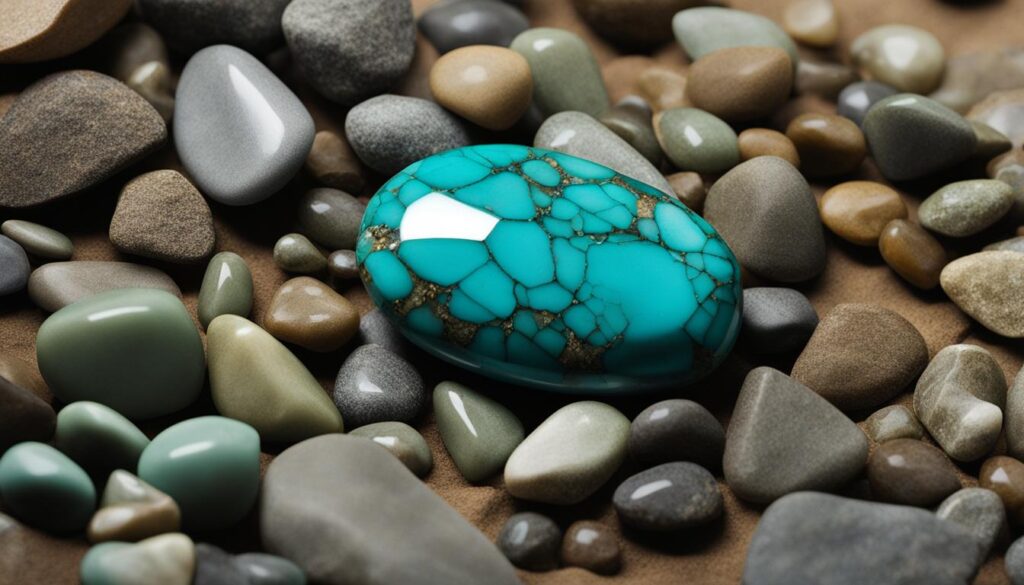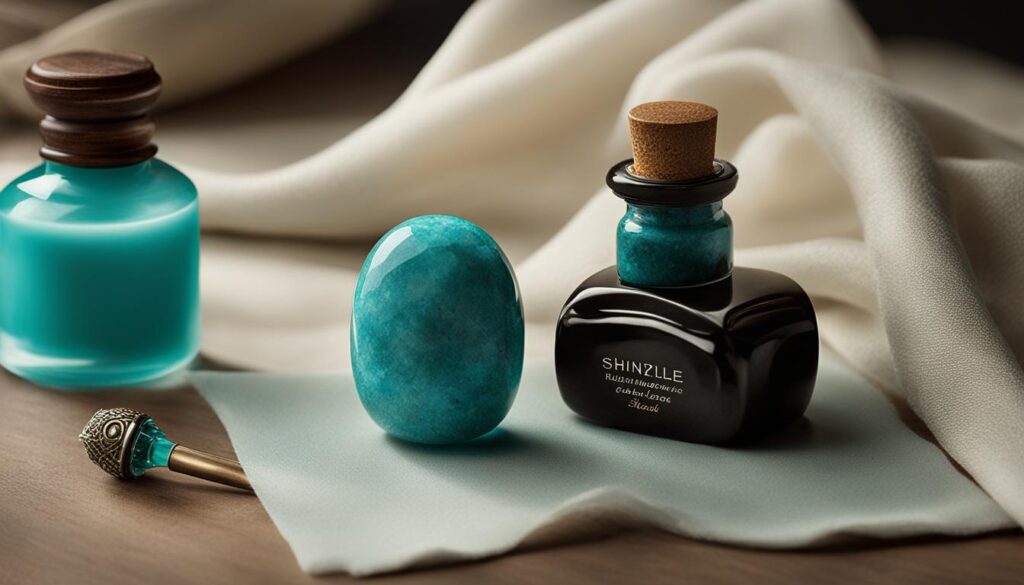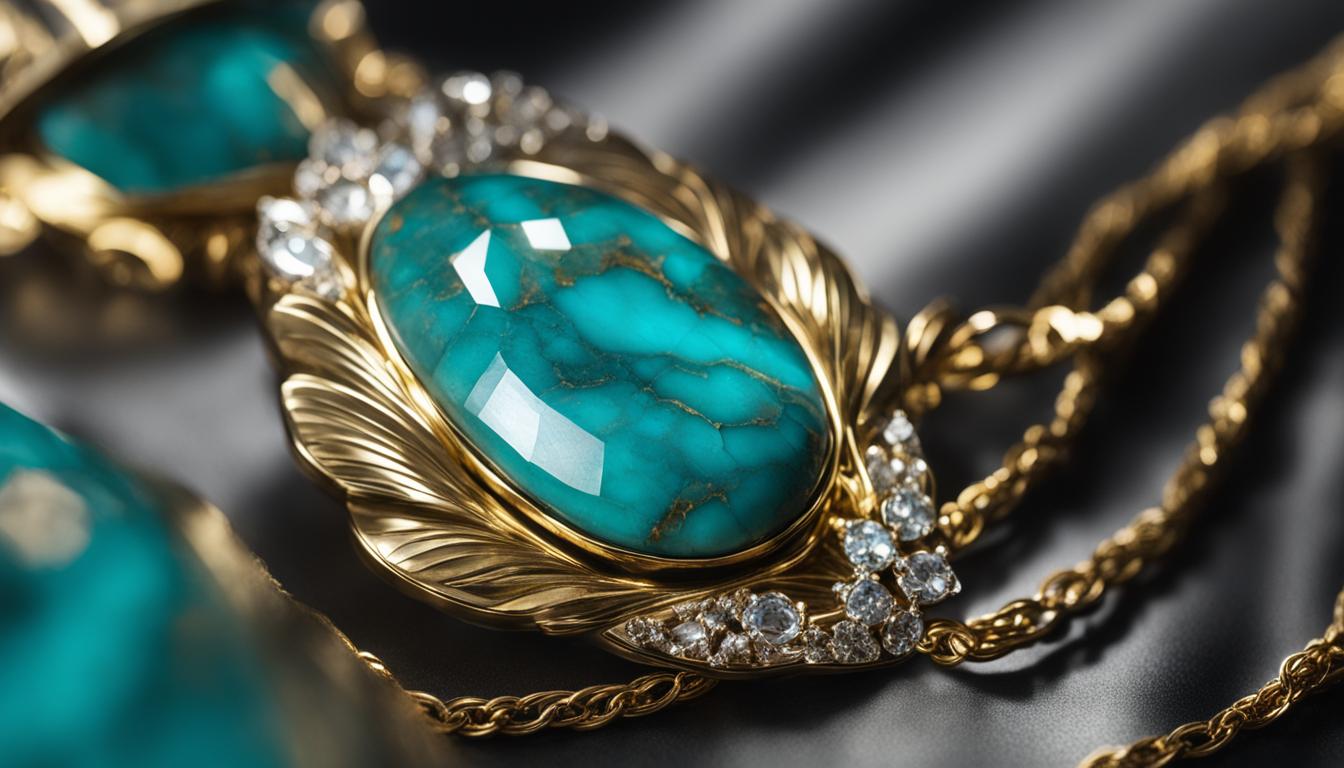Turquoise, a captivating blue-green gem, has long been cherished for its unique beauty. In this guide, we will explore the various aspects and characteristics of turquoise, from its appearance to its color variations. Let’s dive into the world of this shimmering stone and discover what makes it so mesmerizing.
Key Takeaways:
- Turquoise is a captivating blue-green gem with unique beauty.
- Its appearance varies, with different colors and patterns.
- Turquoise can be found in the Southwest regions of the United States, as well as other parts of the world.
- There are different types of turquoise, each with its distinctive features and origin.
- To identify turquoise, look for its vibrant blue-green color, matrix patterns, and smooth appearance.
Where to Find Turquoise – Exploring Nature’s Treasures
Turquoise, with its captivating blue-green hue, is a gemstone that has fascinated people for centuries. But where can you find this shimmering treasure? The answer lies in the natural wonders of the Southwest region of the United States. Specifically, New Mexico and Nevada are the top producers of turquoise, each contributing unique shades and patterns to this exquisite gem.
The arid deserts and mountainous terrain of the Southwest provide the perfect conditions for turquoise formation. The combination of minerals, such as copper and aluminum, and the presence of water over millions of years give rise to the stunning turquoise deposits found in this region. It’s no wonder that Native American tribes have cherished and utilized turquoise in their jewelry and cultural traditions for generations.
While the United States is renowned for its turquoise mines, it’s worth mentioning that turquoise can also be found in other parts of the world. One notable location is Iran, which produces Persian turquoise known for its rich blue color and fine quality. Exploring these different turquoise mining locations allows us to appreciate the diversity and beauty of this enchanting gemstone.
The Top Turquoise Producing Regions:
- New Mexico
- Nevada
The Different Types of Turquoise – A Kaleidoscope of Colors
Turquoise is a gemstone that captivates with its stunning colors and unique variations. Let’s explore the different types of turquoise, each offering its own charm and beauty.
New Lander Turquoise
New Lander turquoise is known for its distinct golden brown matrix and vibrant blue and green colors. It is found in the New Lander Mine in Nevada, and its unique markings make each piece truly one-of-a-kind.
Carico Lake Turquoise
Carico Lake turquoise, named after the Carico Lake Mine in Nevada, is cherished for its light green and blue hues. It is highly sought after for its spiderweb or matrix patterns, which enhance its natural beauty.
Persian Turquoise
Originating from Iran, Persian turquoise is renowned for its rich blue color with a touch of green. It is highly valued for its intense and vibrant shade and has a long history of being used in intricate jewelry and decorative arts.
Blue Gem Turquoise
Blue Gem turquoise, found in Nevada, showcases a vivid sky-blue color and often features dark matrix patterns. Known for its exceptional quality and rarity, it is highly prized by collectors and designers alike.
These are just a few examples of the mesmerizing range of turquoise varieties available. Each type has its own unique characteristics, colors, and origins, making turquoise a truly enchanting gemstone.
Identifying Turquoise – Unveiling Its Beauty
When it comes to identifying turquoise, there are several visual properties to look for. Turquoise is known for its vibrant blue-green color, which is reminiscent of clear tropical waters. This stunning color is one of the key characteristics that sets turquoise apart from other gemstones. Whether it’s a deep sky blue or a rich greenish hue, the color of turquoise is unmistakable.
Another characteristic of turquoise to observe is the presence of matrix or webbing patterns. These unique patterns, caused by the presence of other minerals, give turquoise its distinct personality and charm. Matrix patterns can range from fine spiderweb-like lines to bold and striking veins, adding an extra layer of visual interest to the stone.
“Turquoise is unique in its smooth and even appearance.”
In addition to its color and patterns, turquoise has a smooth and even appearance. This characteristic is often associated with high-quality turquoise. Authentic turquoise is polished to perfection, giving it a glossy surface that reflects light beautifully. The smoothness of turquoise contributes to its overall allure and adds to its jewelry appeal.
Lastly, turquoise has a unique shimmer and luster that sets it apart from other gemstones. When light hits turquoise, it can exhibit a captivating glow, making it truly mesmerizing to behold. This natural luster adds depth and dimension to turquoise jewelry, making it a popular choice for both casual and formal occasions.
Key characteristics to identify turquoise:
- Vibrant blue-green color
- Presence of matrix or webbing patterns
- Smooth and even appearance
- Distinct shimmer and luster
By paying attention to these visual properties, you can confidently identify authentic turquoise and appreciate its beauty in all its forms.

Turquoise in Jewelry – A Symbol of Beauty and Spirituality
Turquoise has been a cherished gemstone in the world of jewelry for centuries. Its stunning blue-green color and unique properties make it a symbol of beauty, protection, and spirituality. Wearing turquoise jewelry not only adds a touch of elegance to your outfit but also carries deeper meanings and benefits.
From ancient civilizations to modern cultures, turquoise has held a special place in jewelry designs. It is believed to bring good fortune, success, and prosperity to the wearer. Turquoise is also associated with healing properties, promoting emotional well-being and positive energy. Its calming effect is said to alleviate stress and anxiety, creating a sense of peace and harmony.
When it comes to turquoise jewelry, the possibilities are endless. You can find turquoise in various forms, including rings, necklaces, bracelets, and earrings. Each piece is unique, showcasing the natural variations in color and texture that make turquoise so captivating. Whether you prefer a simple and understated piece or a bold statement accessory, turquoise jewelry offers something for everyone.
Symbolism and Spiritual Meaning
Turquoise is often regarded as a stone of protection and spiritual connection. In Native American cultures, it is considered a sacred stone that brings good fortune and acts as a shield against negative energies. The vibrant blue color represents the sky and the sea, symbolizing depth, wisdom, and tranquility. Turquoise is also associated with the throat chakra, promoting clear communication, self-expression, and spiritual growth.
- Protection against negative energies
- Emotional healing and well-being
- Success, prosperity, and good fortune
- Clear communication and self-expression
Whether you wear turquoise for its beauty or its spiritual significance, this enchanting gemstone continues to captivate hearts and minds. Its timeless appeal and versatile designs make turquoise jewelry a cherished treasure for generations to come.
Caring for Turquoise – Preserving Its Natural Brilliance
Proper care is essential to maintain the natural brilliance of your turquoise jewelry. As a relatively soft gemstone, turquoise can be susceptible to damage if not handled with care. Here are some practical tips to help you keep your turquoise looking beautiful for years to come:
- Gentle Cleaning: Clean your turquoise jewelry using a soft, lint-free cloth. Avoid using harsh chemicals or abrasive cleaners, as they can damage the stone. Instead, dampen the cloth with mild soapy water or a jewelry cleaning solution specifically formulated for delicate gemstones.
- Storing Safely: When not wearing your turquoise jewelry, store it in a separate compartment or pouch to avoid scratching or tangling with other pieces. It’s also best to keep turquoise away from direct sunlight and extreme temperature changes, as these can cause fading or discoloration.
- Avoid Chemicals: Keep your turquoise jewelry away from chemicals such as perfumes, lotions, and hairsprays. These substances can dull the stone’s luster and potentially damage its surface. It’s recommended to put on your turquoise jewelry after applying cosmetics or beauty products.
- Regular Inspections: Periodically inspect your turquoise jewelry for any signs of damage or loosened settings. If you notice any issues, take it to a professional jeweler for repair. Prompt maintenance can help prevent further damage and prolong the lifespan of your beloved turquoise pieces.
By following these care tips, you can ensure that your turquoise jewelry remains vibrant and stunning, allowing you to enjoy its natural beauty for many years to come.

Turquoise Care Q&A
Q: Can I wear my turquoise jewelry while swimming or showering?
A: It’s best to avoid wearing turquoise jewelry while swimming or showering, as prolonged exposure to water can lead to damage or discoloration. The chemicals in pools, hot tubs, and even tap water can affect the stone’s appearance over time.
Q: How often should I clean my turquoise jewelry?
A: Clean your turquoise jewelry as needed, depending on how frequently you wear it and the level of dirt or debris accumulated. It’s generally recommended to clean turquoise jewelry every few months to keep it looking its best.
Preserving the Brilliance
Turquoise is a gem that deserves proper care to maintain its natural brilliance. By adopting a few simple practices and handling techniques, you can ensure that your turquoise jewelry remains a stunning symbol of beauty for generations to come.
Turquoise in History and Culture – A Stone of Legends
Turquoise, with its captivating blue-green hue, holds a rich history and cultural significance in civilizations around the world. From ancient times to the present day, this enchanting gemstone has been revered as a sacred stone with mystical properties.
In ancient Egyptian culture, turquoise was associated with the goddess Hathor and believed to bring protection, good fortune, and happiness to the wearer. It was also used to adorn jewelry, statues, and amulets, symbolizing eternal life and rebirth.
In Native American tribes, turquoise held deep spiritual meaning and was used in sacred rituals. It was believed to connect the earthly and spiritual realms and bring harmony and balance to individuals and communities.
Across Persian and Tibetan cultures, turquoise was highly valued and considered a stone of protection against evil and harm. It was associated with heavenly blessings and believed to bring prosperity, success, and inner peace.
Turquoise Symbolism and Cultural Significance
Beyond its individual cultural associations, turquoise has been recognized universally as a symbol of beauty, wisdom, and spiritual enlightenment. It is believed to promote emotional well-being, enhance creativity, and foster positive energy.
“The turquoise is a gemstone that has been surrounded by legends for centuries. Its vibrant color and natural brilliance have captivated people across cultures and have made it a treasured symbol of protection, prosperity, and divine connection.” – Gemstone Enthusiast Magazine
Whether worn as jewelry or used in ceremonial objects, turquoise continues to be cherished for its timeless beauty and powerful symbolism. Its enduring allure serves as a testament to the profound influence it has had on human history and culture.
Turquoise in Art and Design – A Versatile Gemstone
Turquoise, with its vibrant colors and unique properties, has long been a favorite among artists and designers. Its mesmerizing shades of blue and green make it a versatile gemstone that adds a pop of color and character to any artistic creation.
In the world of art, turquoise has found its place in various forms. Painters have used it to depict serene landscapes, capturing the essence of turquoise-hued waters and lush meadows. Sculptors have incorporated turquoise into their works, infusing them with a sense of mystique and wonder.
Designers, on the other hand, have embraced turquoise as a chic and timeless element. From jewelry and fashion accessories to home decor and interior design, the possibilities are endless. Turquoise can be used as a focal point or a subtle accent, elevating the aesthetic appeal of any design.
When it comes to the color palette, turquoise offers an exciting range of options. Its various shades and tones can be paired with complementary colors like coral and gold for a vibrant and energetic look. For a more serene and calming ambiance, turquoise can be combined with neutral tones like white and beige.
FAQ
What does turquoise look like?
Turquoise is a captivating blue-green gemstone with a vibrant color and a distinct shimmer and luster.
Where can turquoise be found?
Turquoise is primarily found in the Southwest regions of the United States, with New Mexico and Nevada being the top producers. It can also be found in other parts of the world, such as Iran.
What are the different types of turquoise?
Some recognized types of turquoise include New Lander, Carico Lake, Persian, and Blue Gem turquoise. Each type has its own unique features and origin.
How can I identify authentic turquoise?
Authentic turquoise can be identified by its vibrant blue-green color, the presence of matrix or webbing patterns, and its smooth and even appearance. It also has a distinct shimmer and luster.
What is the significance of turquoise in jewelry?
Turquoise has been used in jewelry for centuries and symbolizes beauty, protection, and spirituality. It is believed to possess healing properties and bring good fortune to its wearer.
How do I care for turquoise jewelry?
Turquoise is a relatively soft gemstone and can be susceptible to damage. To care for turquoise jewelry, it is important to clean it gently and store it properly to protect its natural brilliance.
What is the cultural significance of turquoise?
Turquoise holds a rich history and cultural significance in various civilizations around the world. It has been revered as a sacred stone with mystical properties by ancient Egyptians, Native American tribes, Persian and Tibetan cultures, and more.
How is turquoise used in art and design?
Turquoise’s vibrant colors and unique properties make it a favorite among artists and designers. It can be incorporated into various forms of art and design, adding a pop of color and character to creative creations.




